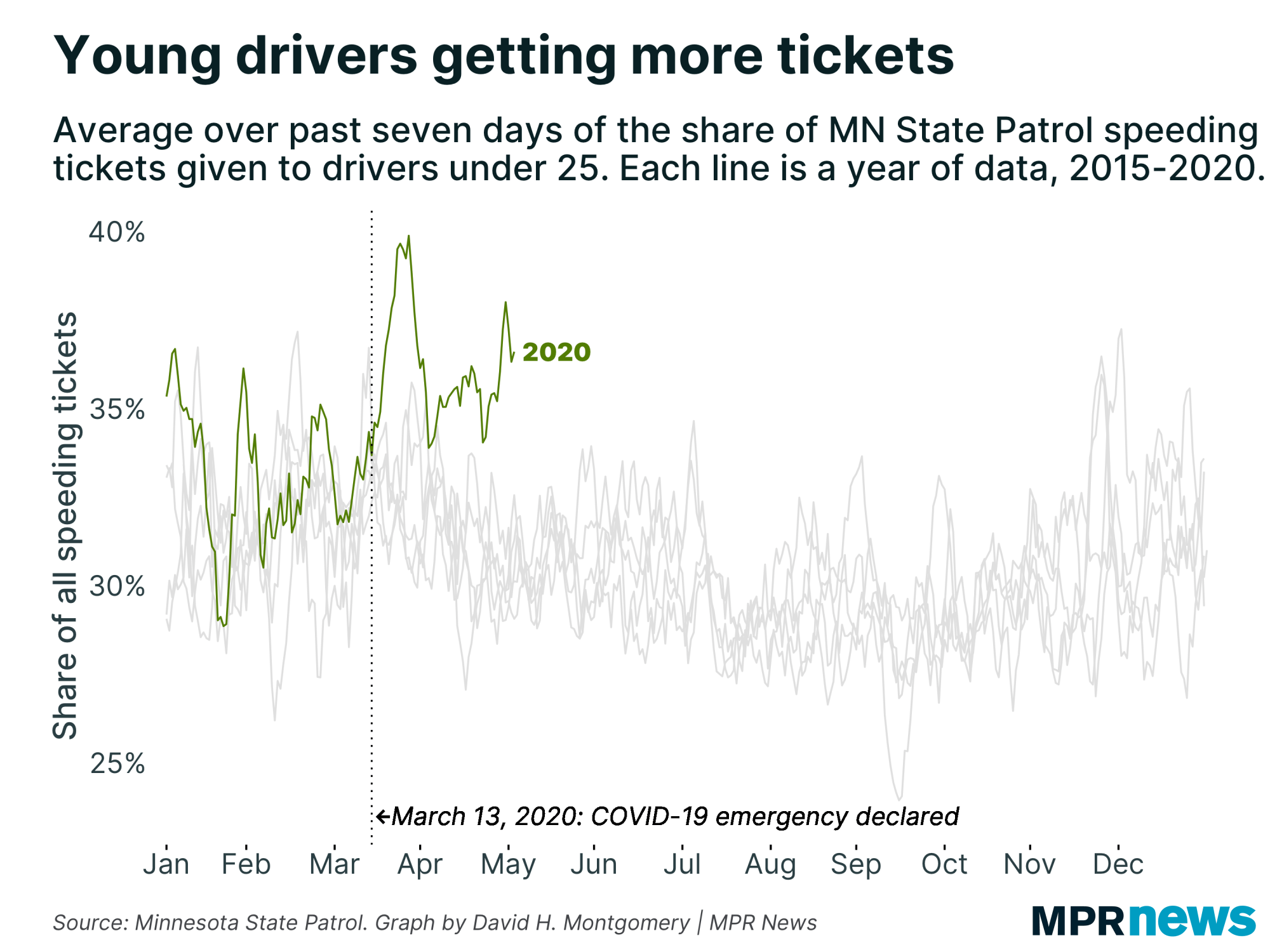Pandemic brings fewer drivers, more speeding to Minnesota highways

Go Deeper.
Create an account or log in to save stories.
Like this?
Thanks for liking this story! We have added it to a list of your favorite stories.
Minnesota drivers have been taking advantage of low traffic caused by COVID-19 quarantines — and flooring it.
The rush in speeding shows up in multiple ways in an MPR News analysis of speeding tickets issued by the Minnesota State Patrol, which enforces traffic laws on Minnesota highways.
Speeding drivers are going faster
Typically, about 10 to 12 percent of all speeding tickets that State Patrol troopers issue are for drivers going more than 20 mph above the posted speed limit.
In mid-March, that rate shot up to record highs, just as the state’s stay-at-home efforts began in earnest. Since early April, the rate of serious speeders has been around 20 percent — twice as high as the usual rate.
Turn Up Your Support
MPR News helps you turn down the noise and build shared understanding. Turn up your support for this public resource and keep trusted journalism accessible to all.

Meanwhile, the share of tickets issued to drivers going less than 10 mph over the posted limit has gone down slightly since the shutdown began, and is currently between 10 and 15 percent — comparable to past years.
“People see the more open road, and there’s less traffic, so they’re more willing to take risks,” said Lt. Gordon Shank, a State Patrol trooper and spokesperson.
The trend is visible in all parts of the state, though it’s more pronounced in the Twin Cities metro area, where highway speed limits are generally lower and where traffic can be a bigger hindrance to vehicle speed when the state’s not under a stay-at-home order.
Fewer cars are on the road
Traffic volume across Minnesota began to fall almost as soon as Gov. Tim Walz declared a state of “peacetime emergency” due to COVID-19 on March 13. Within a week, average traffic statewide was 30 percent below traffic levels the same time in 2019. It has remained well below 2019 levels ever since, including some days where traffic was more than 66 percent below last year’s levels.

Shank said State Patrol troopers are still out enforcing traffic laws during the pandemic — they’ve been issued personal protective gear and have been disinfecting squad cars.
Officers are writing about the same amount of tickets
Though the decreasing amounts of traffic have made it easier for drivers to speed, it’s also made those speeders easier to catch. Despite traffic being down an average of roughly 40 percent, troopers are still writing about as many speeding tickets per day as they do in a typical year.

And, in general, those tickets have been for higher speeds. In recent years, the typical speeding ticket on Minnesota highways is for driving about 14 mph over the speed limit. But since the COVID-19 shutdown began, the typical ticket has been closer to 16 mph over. That seems like a small increase, but it’s by far the highest rate since at least 2014.

Fatal crashes are rising
The increase in speed has brought with it more consequences than expensive tickets. Even though traffic is down, serious car crashes are up, including fatal crashes. From March 16 to April 29, the State Patrol recorded 42 traffic deaths, the second-highest figure since 2015.
Higher speeds, Shank said, can make it tough for drivers to react safely to changes in road conditions.
“The increase in speeds obviously decreases the ability to fix those problems you may run into when you’re driving,” Shank said.
That increase in crashes has also happened despite the fact that cases of impaired drivers — another frequent cause of car crashes — are less frequent, now that all the state’s bars have been closed. Drunk driving hasn’t stopped altogether, even with the bars closed, Shank said.
When troopers do pull people over, Shank said, a common response lately from drivers is that they didn’t realize how fast they were going. That’s a frequent excuse at any time, but anecdotally more common now that the roads are empty.
But another reason troopers are hearing more often is that drivers were “joyriding,” Shank said.
Younger drivers are driving faster
Here the data identifies another interesting change: Since the shutdown began, young drivers are getting a larger share of speeding tickets than they used to.
Even in normal times, drivers under age 25 account for more than 30 percent of speeding tickets written by the State Patrol. But that has risen since the emergency declaration, to an average of 36 percent.

These young drivers are contributing to the overall surge of speeding on Minnesota’s highways, but they don’t explain it. Speeding statistics are still showing big jumps since the shutdown began even if drivers under 25 are excluded.
Shank urged drivers to slow down, and said passengers should speak up if drivers are speeding. Excessive speed is one of the largest contributing factors to crashes, and Shank said the COVID-19 pandemic should make thoughtful drivers speed less rather than more.
“Don’t tie up a hospital bed,” he said.
COVID-19 in Minnesota
Health officials for weeks have been increasingly raising the alarm over the spread of the novel coronavirus in the United States. The disease is transmitted through respiratory droplets, coughs and sneezes, similar to the way the flu can spread.
Government and medical leaders are urging people to wash their hands frequently and well, refrain from touching their faces, cover their coughs, disinfect surfaces and avoid large crowds, all in an effort to curb the virus’ rapid spread.
The state of Minnesota has temporarily closed schools, while administrators work to determine next steps, and is requiring a temporary closure of all in-person dining at restaurants, bars and coffee shops, as well as theaters, gyms, yoga studios and other spaces in which people congregate in close proximity.



